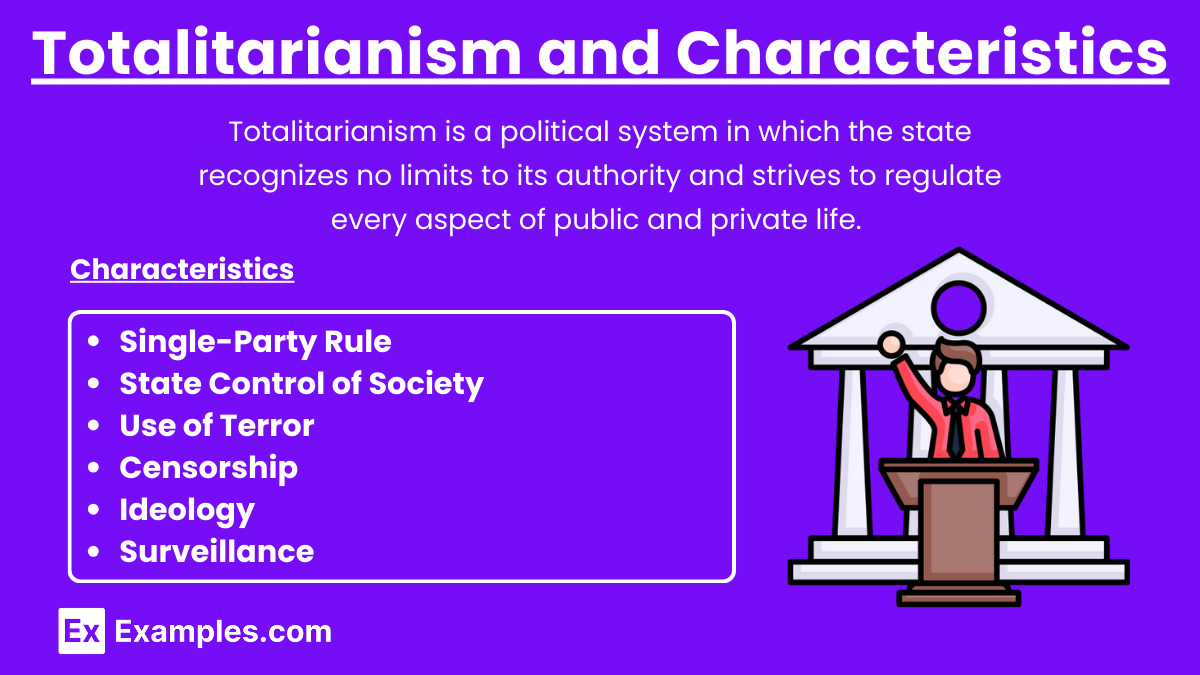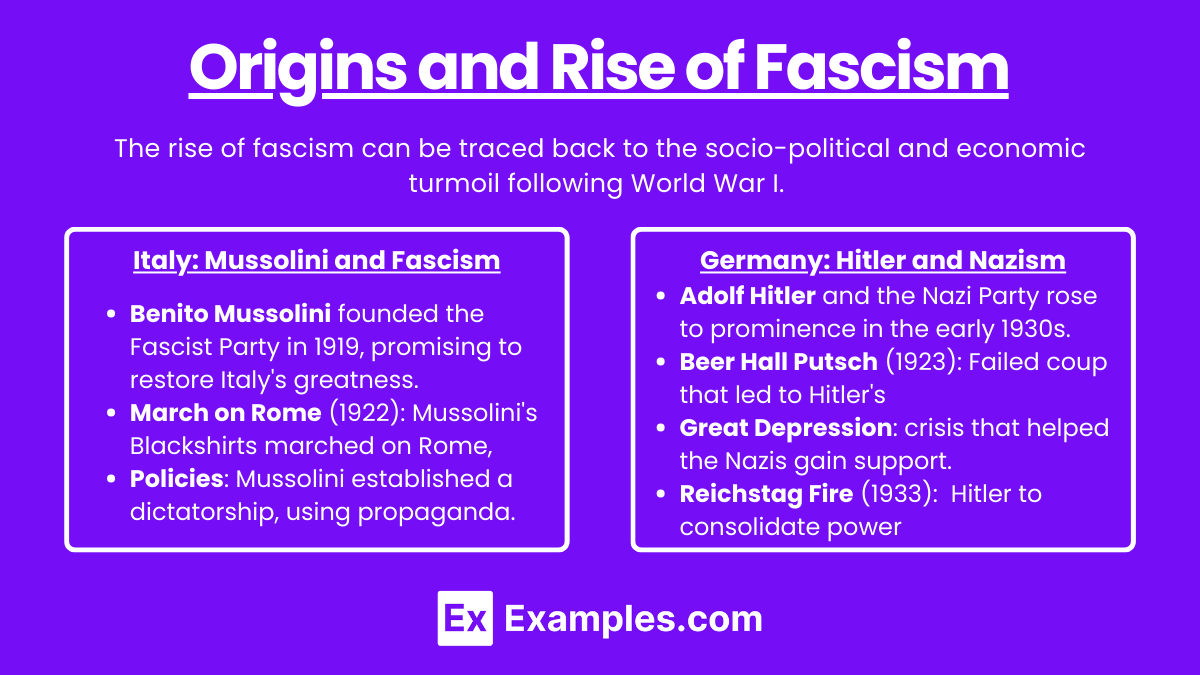Fascism and totalitarian movements profoundly shaped 20th-century European history, leading to authoritarian regimes that controlled many aspects of public and private life. Fascism, with its roots in extreme nationalism and militarism, sought to unify nations under dictatorial rule, exemplified by Mussolini in Italy and Hitler in Germany. For AP European History, understanding totalitarianism, seen in Stalin’s Soviet Union, is crucial as it aimed for absolute control over society through repression and propaganda. These movements are vital for grasping the political and social upheavals of the era.
Learning Objectives
When studying “Fascism and Totalitarian Movements” for the AP European History exam, focus on understanding the origins, key characteristics, and differences between fascism and totalitarianism. Learn about significant leaders like Mussolini and Hitler, their rise to power, and their policies. Analyze the social, economic, and political impacts of these regimes, particularly their use of propaganda, suppression of dissent, and aggressive expansionism. Grasp the historical context and consequences of these movements to effectively evaluate their role in shaping 20th-century European history.
Fascism and Characteristics

Fascism is a far-right, authoritarian ultranationalist political ideology that seeks to create a centralized autocratic government led by a dictatorial leader, with strict social and economic control, and the suppression of opposition through terror and censorship. Fascism rejects democracy, liberalism, and Marxism, promoting instead a vision of a homogeneous national community.
Key Characteristics of Fascism:
- Authoritarianism: Centralized control and limited political freedoms.
- Nationalism: Extreme pride in and devotion to the nation.
- Militarism: Emphasis on military strength and the glorification of war.
- Anti-Communism: Opposition to communist and socialist ideologies.
- Propaganda: Extensive use of propaganda to control public perception.
- Cult of Personality: Leader viewed as a heroic figure embodying national identity.
Totalitarianism and Characteristics

Totalitarianism is a political system in which the state recognizes no limits to its authority and strives to regulate every aspect of public and private life. Totalitarian regimes are characterized by strong central rule that attempts to control and direct all aspects of individual life through coercion and repression.
Key Characteristics of Totalitarianism:
- Single-Party Rule: One political party controls the government.
- State Control of Society: The state controls the economy, education, art, and private life.
- Use of Terror: Systematic use of violence and fear to suppress opposition.
- Censorship: Strict control over information and media.
- Ideology: A guiding, overarching ideology that all members of society are expected to conform to.
- Surveillance: Extensive monitoring of citizens by secret police or other state apparatus.
Origins and Rise of Fascism

The rise of fascism can be traced back to the socio-political and economic turmoil following World War I. The Treaty of Versailles, economic instability, and fear of communism contributed to an environment ripe for extremist ideologies.
Italy: Mussolini and Fascism
- Benito Mussolini founded the Fascist Party in 1919, promising to restore Italy’s greatness.
- March on Rome (1922): Mussolini’s Blackshirts marched on Rome, leading to King Victor Emmanuel III inviting Mussolini to form a government.
- Policies: Mussolini established a dictatorship, using propaganda, secret police, and youth indoctrination to maintain control.
Germany: Hitler and Nazism
- Adolf Hitler and the Nazi Party rose to prominence in the early 1930s.
- Beer Hall Putsch (1923): Failed coup that led to Hitler’s imprisonment and the writing of Mein Kampf.
- Great Depression: Economic crisis that helped the Nazis gain support.
- Reichstag Fire (1933): Used by Hitler to consolidate power and eliminate political opposition.
- Policies: Nazi regime established total control, promoting Aryan superiority, anti-Semitism, and aggressive expansionism.
Totalitarian Movements in the Soviet Union
- Joseph Stalin transformed the Soviet Union into a totalitarian state after Lenin’s death.
- Five-Year Plans: Rapid industrialization and collectivization of agriculture.
- The Great Purge: Campaign of political repression, resulting in the execution and imprisonment of millions.
- Control of Society: Extensive use of propaganda, state-run media, and a pervasive surveillance system.
Impact of Fascism and Totalitarianism
Social Impact
- Suppression of Dissent: Political opposition was ruthlessly suppressed.
- Human Rights Abuses: Widespread use of concentration camps, gulags, and other forms of political repression.
- Cultural Control: Control over artistic expression and intellectual life to promote state ideology
Economic Impact
- State Control of Economy: Centralized planning and control over industries.
- Military Expansion: Economic resources were heavily directed towards military buildup.
Political Impact
- War and Expansionism: Fascist and totalitarian regimes pursued aggressive foreign policies leading to conflicts like World War II.
- Alliances and Rivalries: Complex alliances and rivalries emerged, shaping global politics.
Differences between Fascism and Totalitarianism
| Aspect | Fascism | Totalitarianism |
|---|---|---|
| Ideological Focus | Nationalist and militaristic; emphasizes the supremacy of the nation and often the race. | Complete state control over all aspects of life; ideology varies (e.g., communism) but emphasizes state dominance. |
| Leadership | Centers around a charismatic, dictatorial leader who embodies national identity. | Single-party rule; the party holds ultimate power, with the leader being part of the broader structure. |
| Economic Control | Allows some private ownership and capitalism with significant state intervention. | State ownership and central planning of the economy; aims for complete economic control. |
| Propaganda and Ideology | Uses propaganda to promote nationalistic and militaristic values, often glorifying the past. | Uses propaganda to enforce the state’s ideology in all aspects of life, promoting a future utopian vision. |
| Social Control | Unifies population through nationalist sentiments, creating an “us vs. them” mentality. | Strives for total control over every aspect of citizens’ lives, including thoughts and beliefs. |
| Examples | Nazi Germany under Adolf Hitler, Fascist Italy under Benito Mussolini. | Soviet Union under Joseph Stalin, North Korea under Kim Il-sung and successors. |
Fascism and totalitarianism left a profound impact on 20th-century Europe, shaping its political landscape and leading to significant social and economic upheavals. Understanding these movements, their characteristics, and their consequences is essential for mastering the AP European History Exam. This knowledge not only provides insight into historical events but also underscores the importance of vigilance against similar ideologies in the present day.
Examples
Example 1
Nazi Germany (1933-1945) Nazi Germany, led by Adolf Hitler, exhibited extreme nationalism, racial purity, and a centralized autocratic government. The regime suppressed opposition and pursued aggressive expansionism, leading to World War II and the Holocaust, which resulted in the deaths of millions.
Example 2
Fascist Italy (1922-1943) Fascist Italy, under Benito Mussolini, was characterized by militaristic nationalism, a strong central government, and the suppression of political opposition. The regime also made extensive use of propaganda. Mussolini’s government played a significant role in the lead-up to World War II, allied with Nazi Germany, and engaged in aggressive military campaigns.
Example 3
Soviet Union under Joseph Stalin (1924-1953) The Soviet Union, led by Joseph Stalin, featured single-party rule, the suppression of dissent, and the extensive use of state propaganda. The regime employed widespread terror, resulting in millions of people being imprisoned or executed in purges. Forced collectivization led to widespread famine, and political repression was pervasive throughout Stalin’s rule.
Example 4
Francoist Spain (1939-1975) Francoist Spain, under Francisco Franco, was an authoritarian government that suppressed political opposition, promoted nationalism, and upheld traditional values. The regime was marked by political repression, censorship, and a lack of political freedoms, which continued until Franco’s death in 1975.
Example 5
North Korea under Kim Dynasty (1948-present) North Korea, ruled by the Kim dynasty (Kim Il-sung, Kim Jong-il, and Kim Jong-un), is a hereditary dictatorship characterized by extreme state control, extensive use of propaganda, and the suppression of dissent. The regime fosters a strong cult of personality around its leaders. The impact of this totalitarian rule includes severe human rights abuses, widespread poverty and famine, and the country’s isolation from the global community.
Multiple Choice Questions
Question 1
Which of the following is NOT a characteristic of fascism?
A. Extreme nationalism
B. State control over every aspect of life
C. Emphasis on individual rights and freedoms
D. Use of propaganda to manipulate public opinion
Answer: C. Emphasis on individual rights and freedoms
Explanation: Fascism is characterized by extreme nationalism, state control over many aspects of life, and the use of propaganda to manipulate public opinion. However, it does not emphasize individual rights and freedoms; rather, it suppresses them to maintain the power and control of the state.
Question 2
Who was the leader of the Fascist movement in Italy?
A. Adolf Hitler
B. Benito Mussolini
C. Joseph Stalin
D. Francisco Franco
Answer: B. Benito Mussolini
Explanation: Benito Mussolini was the leader of the Fascist movement in Italy. He founded the Fascist Party in 1919 and became the Prime Minister in 1922, eventually establishing a totalitarian regime. Adolf Hitler led the Nazi Party in Germany, Joseph Stalin led the Communist Party in the Soviet Union, and Francisco Franco led a fascist dictatorship in Spain.
Question 3
Totalitarian movements often employ which of the following tactics to maintain control?
A. Democratic elections
B. Open and free press
C. Intense censorship and surveillance
D. Promotion of political pluralism
Answer: C. Intense censorship and surveillance
Explanation: Totalitarian movements maintain control through intense censorship and surveillance. They suppress dissent, monitor citizens closely, and control the flow of information to ensure that only state-approved narratives are disseminated. Democratic elections, an open and free press, and the promotion of political pluralism are not characteristics of totalitarian regimes.


